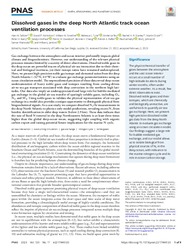Dissolved gases in the deep North Atlantic track ocean ventilation processes
Nicholson, David P.
Stanley, Rachel H. R.
Stute, Martin
Davidson, Perrin W.
Johnson, Rod J.
120, 11: -
DOI: https://doi.org/10.1073/pnas.2217946120
Persistent URL: http://resolver.sub.uni-goettingen.de/purl?gldocs-11858/10525
Persistent URL: http://resolver.sub.uni-goettingen.de/purl?gldocs-11858/10525
Supplement: https://www.bco-dmo.org/project/887496
Seltzer, Alan M.; Nicholson, David P.; Smethie, William M.; Tyne, Rebecca L.; Le Roy, Emilie; Stanley, Rachel H. R.; Stute, Martin; Barry, Peter H.; McPaul, Katelyn; Davidson, Perrin W.; Chang, Bonnie X.; Rafter, Patrick A.; Lethaby, Paul; Johnson, Rod J.; Khatiwala, Samar; Jenkins, William J., 2023: Dissolved gases in the deep North Atlantic track ocean ventilation processes. In: Seltzer, Alan M.; Nicholson, David P.; Smethie, William M.; Tyne, Rebecca L.; Le Roy, Emilie; Stanley, Rachel H. R.; Stute, Martin; Barry, Peter H.; McPaul, Katelyn; Davidson, Perrin W.; Chang, Bonnie X.; Rafter, Patrick A.; Lethaby, Paul; Johnson, Rod J.; Khatiwala, Samar; Jenkins, William J. (2023): Dissolved gases in the deep North Atlantic track ocean ventilation processes - Proceedings of the National Academy of Sciences, Vol. 120, Nr. 11, p. -, DOI: 10.1073/pnas.2217946120.
 |
Dokument öffnen: |
Gas exchange between the atmosphere and ocean interior profoundly impacts global climate and biogeochemistry. However, our understanding of the relevant physical processes remains limited by a scarcity of direct observations. Dissolved noble gases in the deep ocean are powerful tracers of physical air-sea interaction due to their chemical and biological inertness, yet their isotope ratios have remained underexplored. Here, we present high-precision noble gas isotope and elemental ratios from the deep North Atlantic (~32°N, 64°W) to evaluate gas exchange parameterizations using an ocean circulation model. The unprecedented precision of these data reveal deep-ocean undersaturation of heavy noble gases and isotopes resulting from cooling-driven
air-to-sea gas transport associated with deep convection in the northern high lati-tudes. Our data also imply an underappreciated and large role for bubble-mediated gas exchange in the global air-sea transfer of sparingly soluble gases, including O2, N2, and SF6. Using noble gases to validate the physical representation of air-sea gas exchange in a model also provides a unique opportunity to distinguish physical from biogeochemical signals. As a case study, we compare dissolved N2/Ar measurements in the deep North Atlantic to physics-only model predictions, revealing excess N2 from benthic denitrification in older deep waters (below 2.9 km). These data indicate that the rate of fixed N removal in the deep Northeastern Atlantic is at least three times higher than the global deep-ocean mean, suggesting tight coupling with organic carbon export and raising potential future implications for the marine N cycle.

